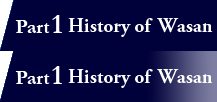Wasan Materials Housed by the National Diet Library
The Wasan materials owned by the Library include various materials such as not only the original texts of the Edo period, but also reproduced versions of those through printing in type or through photography and modern commentaries, any of which can be searched for through databases.
Japanese old books & Chinese classics
For the original books, searching for 「和古書・漢籍」 (Japanese & Chinese Old Materials) with 「件名」=和算 (Subject Heading = "Wasan") brings matches, the majority of which are the Wasan books of the Edo period. Half of the matched books are manuscripts. Searching with 「件名」= 測量 (Subject Heading = "survey") brings matches of survey books.
The Library also owns Chinese classics dealing with mathematics. In this case, searching with 「件名」= 算法 or 算書 (Subject Heading = "arithmetic" or "mathematical books") brings matches of Chinese mathematical books.
For books on astronomy and calendars, searching with 「件名」= 天文 or 暦 (Subject Heading = "astronomy" or "calendar") brings matches of Japanese old books and Chinese classics.
Honkoku version
The honkoku version refers to a version of a book that has the same content as the original book (manuscript or wood-block book) and is created as a separate version, and the one that is printed in type. In the prewar period, when photocopying was more difficult than today, many honkoku versions were produced.
Old examples of the Wasan books that were reproduced through printing in type as Japanese classics include Warizansho, Jinkoki, Shokan bumono, Jugairoku, and Inki sanka, which were published as Kodai sugakushu 1 & 2 (1927) in the series: Nihon koten zenshu, which the Japanese Classic Publication Association established by Masamune Atsuo (1881-1958) began publishing from the fourteenth year of the Taisho era (1925). In the Showa era, researchers who read Wasan books systematically increased in number, with Sawamura Hiroshi responding to the demand by printing more than 200 Wasan books by mimeograph under the publisher's name of Sawamura Shahon Do or Koten Sugaku Shoin, during the eighth to the thirteenth years of Showa (1933-38).
In the postwar period, the publication of Wasan senshu in a total of eight volumes was planned by Kodansha, but was not carried out. Instead, Kenseisha has published Edo shoki Wasan sensho since the second year of the Heisei era (1990), and it has so far published 33 books in 11 volumes.
Fukkoku version
The fukkoku version refers to the facsimile version of a book produced by faithfully reproducing the original book based on pictures of the book, etc.
In the postwar period, with the progression of photography using microfilms, it has become easy to reproduce a book in its original form. Due to the ease of producing a fukkoku version using images, many facsimile versions have been published. In Nihon kagaku gijutsu kotenseki shiryo sugaku (1), published by Kagaku Shoin, Inc. since the thirteenth year of the Heisei era (2001), many facsimile versions of Wasan books have been reproduced, mainly from those owned by the Japan Academy.
The CD-ROM Wasan sho shusei: Nakasone Soho Collection (2001, by Iwanami Shoten), which was reproduced through electronic media, includes about 300 Wasan books.
Wasan books in the Meiji era
Wasan books were published even in the Meiji era. Some of them can be viewed on the Internet.Searching with "NDC classification" = 419 brings matches of such books.
History of mathematics & Wasan history
Searching for "Books" with "Subject Heading" = "Wasan" brings matches of books. Some include those described above, but many of them are Wasan research materials published in the postwar period.


